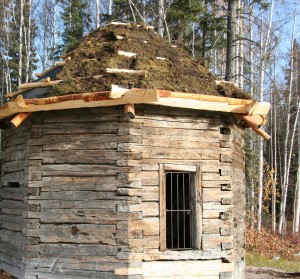Museum completes Russian blockhouse preservation
October 28, 2011

907-474-6941
10/28/11
An 1841 Russian blockhouse is again sitting tall on the grounds of the University of Alaska Museum of the North.
The roof was removed from the Kolmakovsky blockhouse in 2006 due to questions of structural stability and safety. In December of 2009, the Save AmericaŌĆÖs Treasures Program awarded the museum $75,000 to preserve the Kolmakovsky collection. After relocating the building to a tree-sheltered site on a new foundation and replacing a number of rotten logs, the preservation team completed the work on the blockhouse this fall by reattaching an updated roof outfitted with tundra sod and tamarack poles.
ŌĆ£We used materials with rot-resistant properties to help the long-term preservation of the building,ŌĆØ said Angela Linn, the museumŌĆÖs ethnology and history collection manager.
The blockhouse was the first structure built by the Russian-American Company at Kolmakovsky Redoubt near Aniak. It is one of the oldest Russian-era structures in Alaska. In 1929, the blockhouse was disassembled and moved to Fairbanks.
For this project, Linn worked closely with log preservation specialist Sandy Jamieson. He was especially intrigued with the unique notching system used in the blockhouse construction. The design features self-locking dovetail notches built into the chinkless white spruce logs, something he had never seen before.
ŌĆ£It was very satisfying to reassemble the building,ŌĆØ Jamieson said. ŌĆ£Everything just went together ŌĆō click, click, click. It was a nice connection to the guys who had cut those logs 170 years ago.ŌĆØ
Linn hopes to use the information the team gathered about the blockhouseŌĆÖs architectural design in future projects. ŌĆ£ThereŌĆÖs a whole story embedded in the logs themselves,ŌĆØ Linn said.

The Save AmericaŌĆÖs Treasures grant, a joint initiative of the National Park Service, the Institute of Museum and Library Services, the National Endowment for the Arts, the National Endowment for the Humanities and the PresidentŌĆÖs Committee on the Arts and Humanities, also provided funding to improve the storage for these artifacts and to make them more accessible to researchers.
ŌĆ£For me, as an anthropologist, the objects are great in and of themselves, but whatŌĆÖs really intriguing are those stories associated with the objects,ŌĆØ Linn said.
Putting the roof back on the blockhouse was the last step in stabilizing the building, but itŌĆÖs just the beginning of the museumŌĆÖs plans for the Kolmakovsky collection. New interpretive panels will be built to explain the buildingŌĆÖs role in the culture and history of Alaska, and the structure will serve as the trailhead marker to a planned interpretive trail on campus.
Linn will soon have two houses to take care of when the St. Michael blockhouse returns to Fairbanks after being on loan to the Anchorage Museum since the 1980s.
ŌĆ£These objects keep people aware of this time period. We are achieving our goal of outreach and education by sharing them with the public,ŌĆØ said Linn.
ADDITIONAL CONTACTS: Angela Linn, museum ethnology and history collection manager, at 907-474-1828 or via e-mail at ajlinn@alaska.edu.
ON THE WEB:
NOTE TO EDITORS: Images of the blockhouse are available for download from .
TB/10-28-11/099-12


